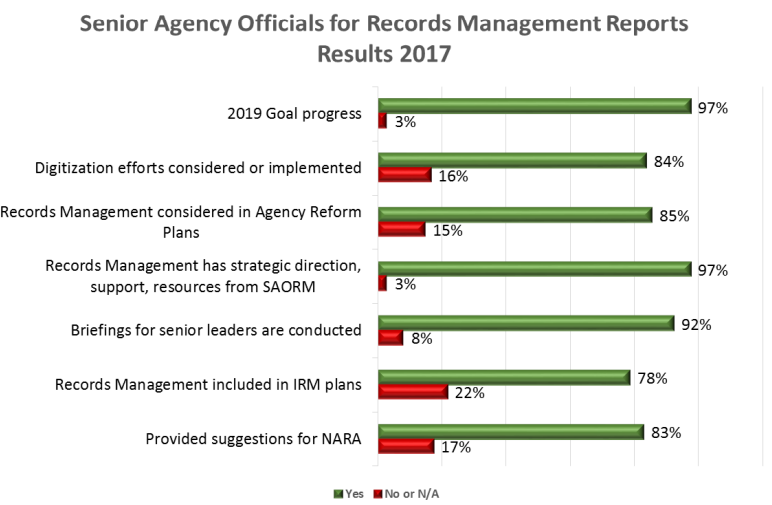

The vast majority of agencies claim they're on track to meet a key deadline in the path towards making the government less dependent on paper records, according...
Most agencies claim they’re on track to meet a key deadline in the path toward making the government less dependent on paper records, according to a new report from the National Archives and Records Administration.
In the report, 98 percent of agencies said they were confident in their ability to manage all permanent electronic records by Dec. 31, 2019, mandated by a joint directive from the Office of Management and Budget and NARA.
“Overall, the great majority of federal agencies reported they are working towards transitioning from maintaining the costly separate policies, practices, and physical infrastructures in traditional (analog) formats to managing records electronically,” NARA wrote in its 2017 Federal Agency Records Management report, which it released Wednesday.
The push for agencies to implement more electronic record-keeping falls in line with both NARA’s strategic plan, which outlines several transformational goals for the agency between now and 2022, and the Trump administration’s sweeping government reorganization plan.
According to the reorganization plan, which the White House released in June, agencies spend billions of dollars keeping and maintaining paper-based records. And despite multiple attempts to curb their reliance on paper, the Trump administration found agencies have been “inconsistent and ineffective” in their transition toward digital records.
“As agencies implement electronic processes in place of paper, it will be easier for the public to connect with the federal government, and apply for and receive services, improving customer satisfaction. Electronic records will reduce processing times and decrease the probability of lost or missing information,” the White House wrote in its reorganization plan.
Over the long term, the administration expects agencies will spend less on records management and storage costs, and will streamline the records management process.
NARA currently holds more than 12.5 billion pages of documents, totaling 5 million cubic feet of space — enough to fill nearly 60 Olympic-sized swimming pools. It expects to receive an additional 3 million cubic feet of records by fiscal 2030.
Through its Federal Records Centers Program, NARA also stores more than 28 million cubic feet of records on a temporary basis for other agencies. Those agencies spend about $200 million every year for the National Archives to keep those records.
But as agencies offer contracts for records management and storage services to reduce their dependence on paper records, they also need to manage their current inventory of electronic records.
In 2005, NARA managed about 12 billion pages of electronic archives. Now it keeps track of more than 34 billion pages.
“Without focused attention to this challenge, NARA and agencies will face inadequate electronic records systems and protocols, leading to higher costs and lost records, as well as deficient practices and services for paper records,” the White House report said.
In a survey of senior agency officials for records management (SAORMS), 97 percent said their agencies made progress last year on the goal to manage all permanent electronic records in electronic format by Dec. 2019

NARA began its Federal Electronic Records Modernization Initiative (FERMI) in October 2015. Through that strategy, agencies face several key deadlines in the transition to electronic records.
As its first major milestone, NARA directed agencies to manage all of their email records in an accessible, electronic format by 2016.
“Up until that point, a lot of agencies were printing and filing their emails as the official record,” Courtney Anderson, an electronic records policy analyst at NARA, said Thursday in an ACT-IAC meeting at the General Services Administration’s headquarters.
By 2022, NARA will no longer accept temporary or permanent records from agencies in a non-electronic format.
Anderson said FERMI aims to help agencies reach these records modernization milestones through guidance and policy.
“We heard a lot from agencies that NARA does a good job of telling agencies what they need to do, but agencies need more help with the ‘how.’ This is our way of addressing the ‘how’ — how can they address their electronic records automatically, how can they more easily transfer electronic records to the National Archives?” Anderson said.
Under FERMI, the agency has two goals:
In order to meet those goals, NARA has collaborated with GSA’s Office of Shared Solutions and Performance Improvement since 2016.
Last year, at GSA’s urging, NARA issued its Universal ERM Requirements, which addresses the six stages in the lifecycle of records:
“They suggested that we start this effort by coming up with the core requirements that all agencies need to follow for electronic records management. We also heard this from agencies too — that agency records officers needed help with the procurement process. They needed help writing the requirements for their statement of work,” Anderson said.
NARA created the section-by-section requirements through an interagency working group, which included the departments of Defense, Education, and Health and Human Services, as well as the Consumer Financial Protection Bureau and GSA.
The requirements instruct agencies how to process 11 types of records including electronic messages, social media, websites, and digital media, like photos and video.
“This is a high-level document, and it’s a starting point for agencies, and then they can tailor these to fit their specific needs,” Anderson said.
Working with GSA’s Schedule 36 team, NARA also created a Special Item Number (SIN 51 600) for electronic records management last October.
“We wanted to create a new Special Item Number specifically for electronic records management,” Anderson said. “We wanted to have a place where we could point agencies and say, you can use this contract vehicle to help you get to vendors that have ERM solutions. We heard a lot from agencies: ‘What do I do? How should I start the process? And now we have somewhere where we can point them.”
GSA currently has 38 vendors listed under that under SIN.
Looking ahead, GSA and NARA are asking vendors to create video demos that walk agencies through several records management scenarios. GSA will make the demos available on its Acquisition Gateway.
The agencies request agencies come up with video demos for the following scenarios:
Copyright © 2024 Federal News Network. All rights reserved. This website is not intended for users located within the European Economic Area.
Jory Heckman is a reporter at Federal News Network covering U.S. Postal Service, IRS, big data and technology issues.
Follow @jheckmanWFED


